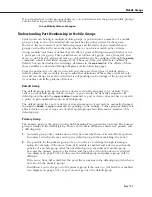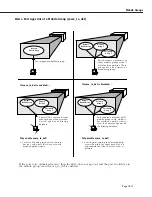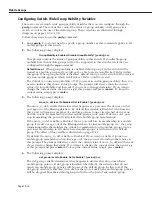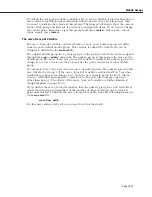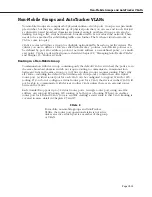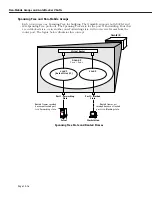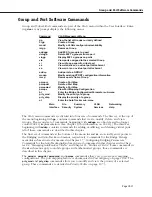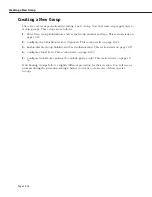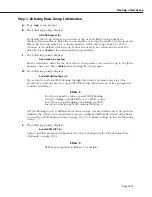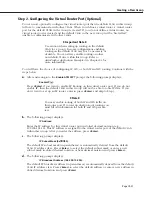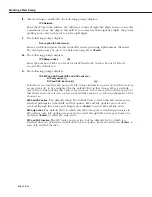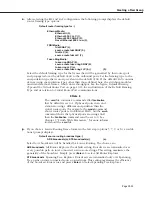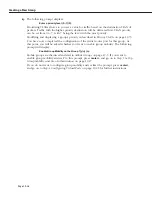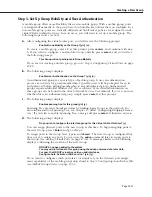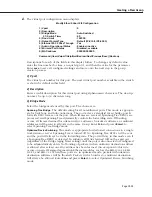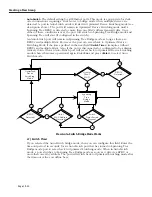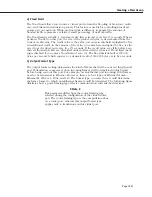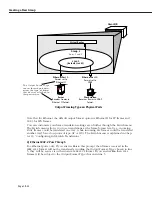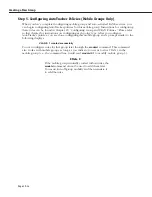
Creating a New Group
Page 19-21
Step 2. Configuring the Virtual Router Port (Optional)
You can now optionally configure the virtual router port that the default
VLAN
in this Group
will use to communicate with other
VLAN
s. When you define a virtual router, a virtual router
port for the default VLAN in the Group is created. If you do not define a virtual router, no
virtual router port is created and the default
VLAN
in the new Group will be “firewalled,”
unable to communicate with other
VLAN
s.
♦
Important Note
♦
Use caution when setting up routing on the default
VLAN
for a Group. In some configurations enabling
routing on the default
VLAN
may not be necessary or
desirable. You can always enable routing on other,
non-default
VLAN
s, within this Group. Refer to
AutoTracker Application Example 4
in Chapter 24 for
more information.
You will have the choice of configuring
IP
,
IPX
, or both
IP
and
IPX
routing. Continue with the
steps below:
a.
After answering
n
to the
Enable ATM CIP?
prompt, the following prompt displays:
Enable IP (y):
Press
<Enter>
if you want to enable IP Routing on this virtual router port. If you do not
enable IP, then the default
VLAN
in this Group will not be able to route IP data. If you
don’t want to set up an IP router, enter
n
, press
<Enter>
and skip to Step j.
♦
Note
♦
You may enable routing of both
IP
and
IPX
traffic on
this router port. If you set up dual-protocol routing, you
must fill out information for both
IP
and
IPX
parame-
ters.
b.
The following prompt displays:
IP Address:
Enter the IP address for this virtual router port in dotted decimal notation (e.g.,
198.206.181.10). This IP address is assigned to the virtual router port of the default
VLAN
within this Group. After you enter the address, press
<Enter>
.
c.
The following prompt displays:
IP Subnet Mask (0xffffff00):
The default IP subnet mask (in parentheses) is automatically derived from the default
VLAN IP
address class. Press
<Enter>
to select the default subnet mask or enter a new
subnet mask in dotted decimal notation or hexadecimal notation and press
<Enter>
.
d.
The following prompt displays:
IP Broadcast Address (198.200.10.255):
The default IP broadcast address (in parentheses) is automatically derived from the default
VLAN IP
address class. Press
<Enter>
to select the default address or enter a new address in
dotted decimal notation and press
<Enter>
.
Summary of Contents for Omni Switch/Router
Page 1: ...Part No 060166 10 Rev C March 2005 Omni Switch Router User Manual Release 4 5 www alcatel com ...
Page 4: ...page iv ...
Page 110: ...WAN Modules Page 3 40 ...
Page 156: ...UI Table Filtering Using Search and Filter Commands Page 4 46 ...
Page 164: ...Using ZMODEM Page 5 8 ...
Page 186: ...Displaying and Setting the Swap State Page 6 22 ...
Page 202: ...Creating a New File System Page 7 16 ...
Page 270: ...Displaying Secure Access Entries in the MPM Log Page 10 14 ...
Page 430: ...OmniChannel Page 15 16 ...
Page 496: ...Configuring Source Route to Transparent Bridging Page 17 48 ...
Page 542: ...Dissimilar LAN Switching Capabilities Page 18 46 ...
Page 646: ...Application Example DHCP Policies Page 20 30 ...
Page 660: ...GMAP Page 21 14 ...
Page 710: ...Viewing the Virtual Interface of Multicast VLANs Page 23 16 ...
Page 722: ...Application Example 5 Page 24 12 ...
Page 788: ...Viewing UDP Relay Statistics Page 26 24 ...
Page 872: ...The WAN Port Software Menu Page 28 46 ...
Page 960: ...Deleting a PPP Entity Page 30 22 ...
Page 978: ...Displaying Link Status Page 31 18 ...
Page 988: ...Displaying ISDN Configuration Entry Status Page 32 10 ...
Page 1024: ...Backup Services Commands Page 34 14 ...
Page 1062: ...Diagnostic Test Cable Schematics Page 36 24 ...
Page 1072: ...Configuring a Switch with an MPX Page A 10 ...
Page 1086: ...Page B 14 ...
Page 1100: ...Page I 14 Index ...

